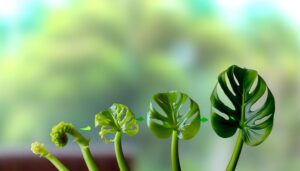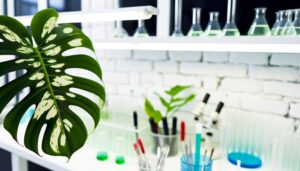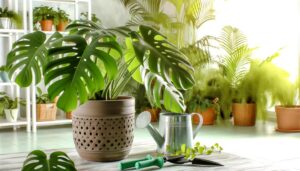Monstera Aurea Borsigiana Golden Variegated
You'll discover the Monstera Aurea Borsigiana Golden Variegated a botanical marvel, renowned for its striking golden variegation and intricate fenestrations. This plant, native to Central and South American rainforests, climbs trees to access light.
Golden variegation stems from a genetic mutation affecting chlorophyll distribution, while aerial roots aid in nutrient absorption and support. Best care includes bright indirect light, temperatures between 65-80°F, and humidity levels above 60%.
Water when the soil's top 2-3 inches are dry and use a balanced fertilizer. Effective propagation methods include stem cuttings and air layering.
For a deeper exploration into these techniques and more, continue onwards.
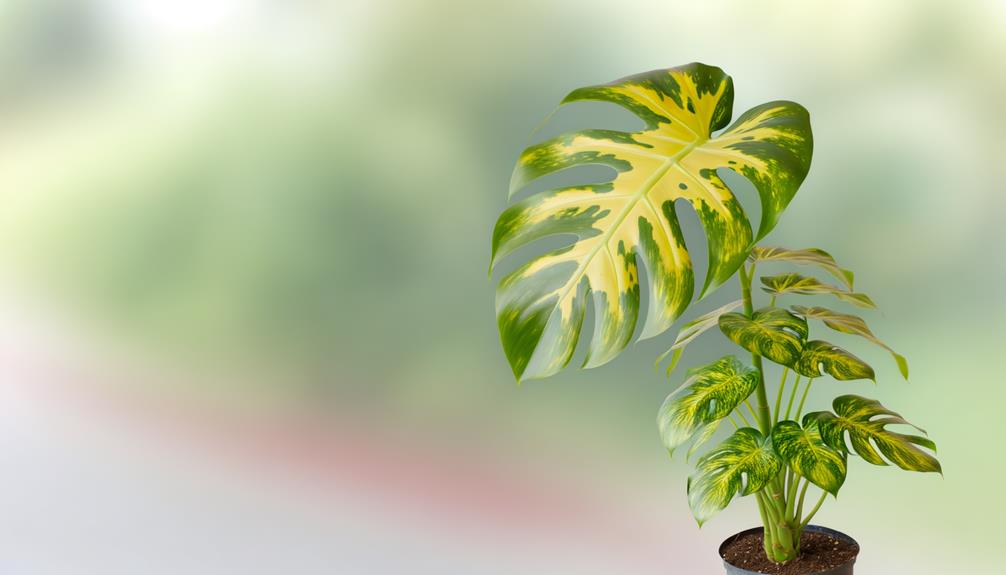
Key Takeaways
- Monstera Aurea Borsigiana Golden Variegated features striking golden variegation due to a genetic mutation.
- The plant requires bright indirect sunlight, well-draining soil, and high humidity for optimal growth.
- Each leaf can grow up to 60 centimeters long and has unique variegation patterns.
- Water when the top 2-3 inches of soil are dry and use a balanced 20-20-20 fertilizer diluted to half strength.
- Propagation methods include stem cuttings, air layering, and division, all promoting healthy root development.
Origin and History

The Monstera Aurea Borsigiana Golden Variegated, a cultivar of the Monstera deliciosa, traces its origins to the tropical rainforests of Central and South America.
You'll find this fascinating plant thriving under the dense canopy where humidity is high, and light is filtered. These conditions favor its epiphytic growth habit, allowing it to climb trees for better light access.
Historically, indigenous cultures utilized Monstera species for food and medicinal purposes, recognizing their unique properties. Over time, the Monstera Aurea Borsigiana has been selectively bred for its striking variegation.
This selective breeding has resulted in the beautiful golden patterns you see today, making it a highly sought-after specimen among horticultural enthusiasts and collectors worldwide.
Unique Features
Monstera Aurea Borsigiana Golden Variegated captivates with its striking golden variegation, characterized by irregular patterns of yellow and green on each leaf. The variegation results from a genetic mutation affecting chlorophyll distribution, creating a mosaic of chlorotic and chlorophyllous sectors.
You'll notice the fenestrations, or natural holes, which increase in number as the plant matures, enhancing its aesthetic appeal. Each leaf measures up to 60 centimeters in length and exhibits a glossy texture. The plant's aerial roots, which emerge from nodes along the stem, aid in nutrient absorption and structural support. Its stem is robust, ensuring stability.
This cultivar's unique variegation pattern varies from leaf to leaf, making every specimen a singular botanical marvel.
Ideal Growing Conditions
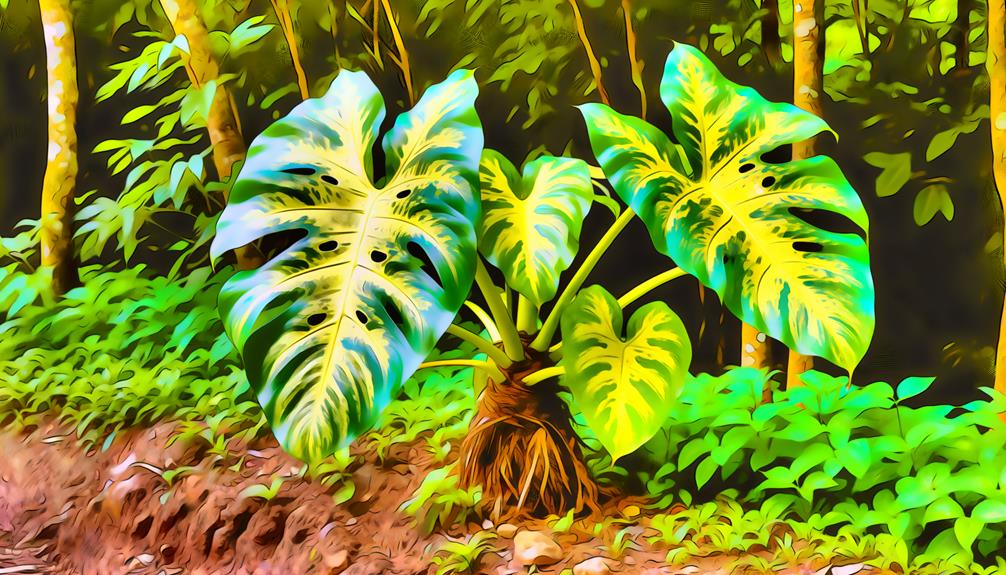
To sustain the stunning variegation and robust growth of your Monstera Aurea Borsigiana Golden Variegated, you need to provide ideal light conditions, ideally bright indirect sunlight. Position your plant near an east or south-facing window where it can receive filtered sunlight throughout the day. Avoid direct sunlight as it can scorch the delicate variegated leaves, leading to chlorophyll degradation.
Maintain a temperature range of 65-80°F (18-27°C) to ensure peak metabolic activity. Humidity levels should be kept high, preferably between 60-80%, to mimic its native tropical environment. Use a well-draining soil mix that retains some moisture but prevents waterlogging, promoting healthy root aeration.
These conditions will help your Monstera thrive and showcase its golden variegation.
Watering and Feeding
Maintaining your Monstera Aurea Borsigiana Golden Variegated's vibrant foliage and overall health requires adequate watering and feeding.
Water the plant when the upper 2-3 inches of soil feel dry to the touch. Use lukewarm water to avoid root shock. Strive for consistent moisture without overwatering, which can result in root rot.
For feeding, apply a balanced, water-soluble fertilizer with an N-P-K ratio of 20-20-20 every 4-6 weeks during the growing season. Dilute the fertilizer to half strength to prevent nutrient burn.
Furthermore, flush the soil occasionally to eliminate accumulated salts. This routine guarantees optimal nutrient absorption and promotes the plant's growth and variegation.
Common Problems
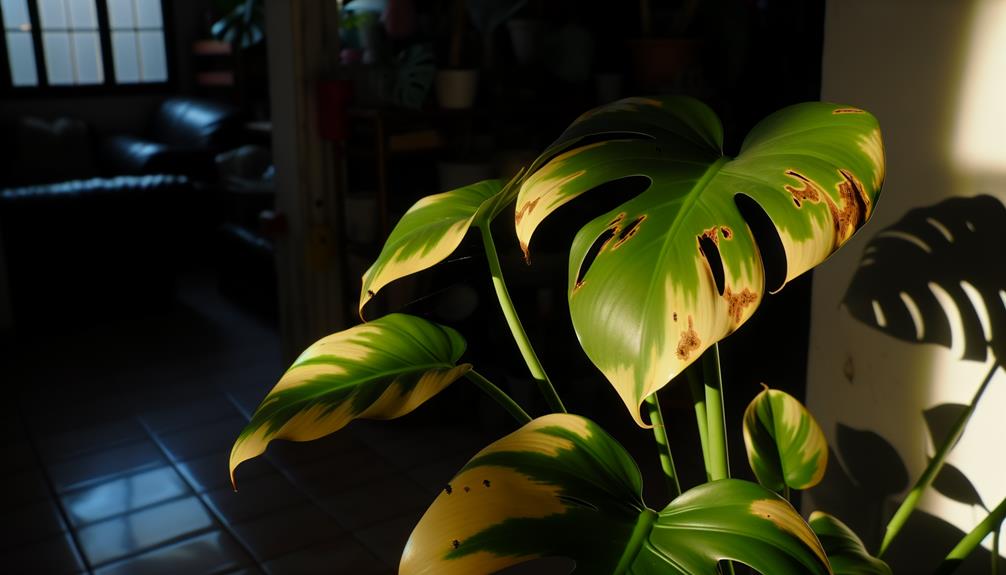
While maintaining a best watering and feeding routine, you'll also need to be watchful about common problems such as leaf browning, pests, and fungal infections. Leaf browning often indicates improper watering or low humidity. Verify soil moisture is consistent but not waterlogged. Check humidity levels; Monstera Aurea Borsigiana prefers 60-80%.
Pests like spider mites and mealybugs can harm your plant. Inspect leaves regularly and use insecticidal soap or neem oil for treatment.
Fungal infections, often caused by overwatering, manifest as root rot or leaf spots. Enhance air circulation, avoid wet foliage, and use a fungicide when necessary.
Addressing these issues promptly helps maintain the health and vibrancy of your Monstera Aurea Borsigiana Golden Variegated.
Propagation Methods
To propagate Monstera Aurea Borsigiana Golden Variegated, utilize methods such as the stem cutting technique, air layering process, and division and repotting.
You'll need to ensure precise cutting angles, ideal humidity, and appropriate substrate to maximize success.
Each technique has specific requirements, but all aim to encourage healthy root development and vigorous new growth.
Stem Cutting Technique
Monstera Aurea Borsigiana's stem cutting technique is a popular propagation method. It involves precisely severing a healthy stem segment that includes at least one node and aerial root. Use sterilized pruning shears to cut the stem below the node, maintaining a clean cut to prevent infection.
Place the cutting in water or a well-draining soil mix, maintaining high humidity and indirect light. Monitor root development, which typically initiates within 2-4 weeks. Guarantee the cutting has sufficient moisture by misting regularly and avoiding overwatering.
Once roots are 2-3 inches long, transplant it into a pot with an appropriate substrate. This method guarantees the genetic consistency and variegation of the Monstera Aurea Borsigiana.
Air Layering Process
In the air layering process, you promote root development by creating a small wound on a healthy stem and wrapping it with moist sphagnum moss and plastic to maintain high humidity.
First, select a robust stem and make a shallow incision, removing a small strip of bark. Apply rooting hormone to the exposed area to stimulate root growth.
Next, envelop the wound with damp sphagnum moss, guaranteeing full coverage. Secure the moss with plastic wrap, sealing the edges to retain moisture. Over time, roots will form within the moss.
Once a substantial root system develops, sever the stem below the new roots and plant it in soil. This method guarantees a higher success rate for propagating your Monstera Aurea Borsigiana Golden Variegated.
Division and Repotting
After mastering air layering, you can also propagate your Monstera Aurea Borsigiana Golden Variegated through division and repotting. This involves separating the plant into smaller sections, each with its own root system.
First, remove the plant from its container, gently disentangling the roots. Carefully identify natural divisions where the plant has multiple stems and root clusters. Using a sterile knife, sever these sections, ensuring each has adequate roots attached.
Repot each division into appropriately sized containers with well-draining soil. Water thoroughly to help settle the soil around the roots. Maintain high humidity and indirect light to reduce transplant shock.
This method not only propagates new plants but also rejuvenates the original plant by encouraging new growth.
Styling Tips
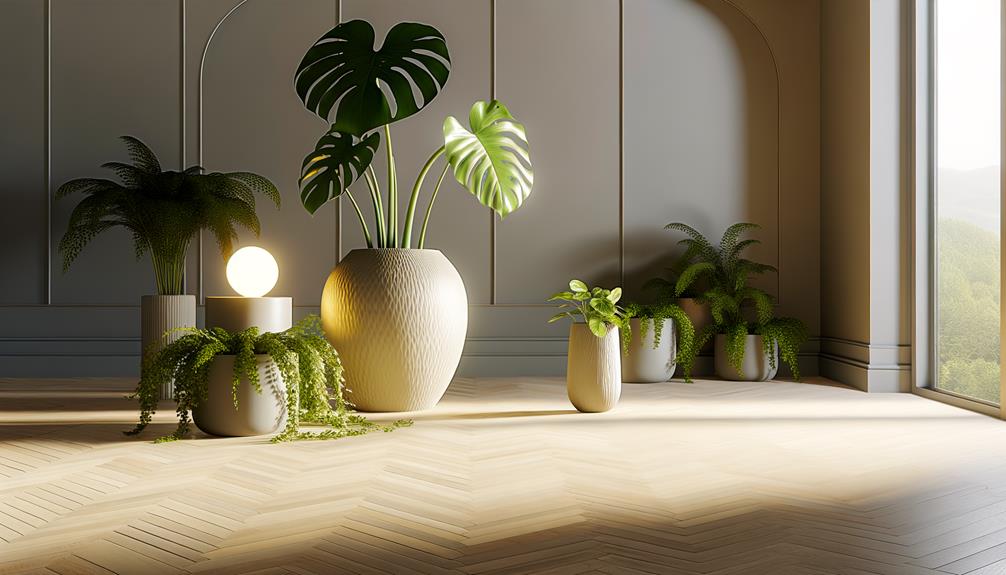
When styling your Monstera Aurea Borsigiana Golden Variegated, consider utilizing indirect lighting to enhance its variegation and maintain ideal leaf health. Position your plant near a north or east-facing window to provide ideal light levels without risking leaf burn. Make sure the environment has consistent humidity, ideally above 60%, to prevent leaf browning and promote lush growth.
Support Structures: Use moss poles or trellises to guide vertical growth and mirror natural climbing habits.
Aesthetic Containers: Select pots with adequate drainage and a visually appealing design to complement your interior decor.
Soil Composition: Use a well-draining soil mix rich in organic matter to facilitate root aeration and moisture control.
Pruning Techniques: Regularly trim damaged or yellow leaves to encourage robust growth and maintain an attractive appearance.
Conclusion
To conclude, Monstera aurea borsigiana, with its golden variegation, offers both aesthetic appeal and botanical intrigue.
You'll find that under ideal conditions, this plant can grow up to two feet per year, adding substantial vertical interest to your space.
Cultivating this unique plant involves precise care when it comes to lighting, watering, and feeding.
With proper attention, you'll not only enjoy its lush beauty but also contribute to the preservation of this fascinating cultivar.

